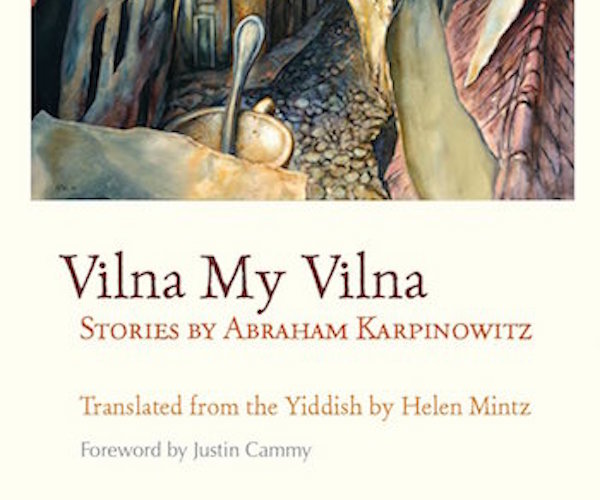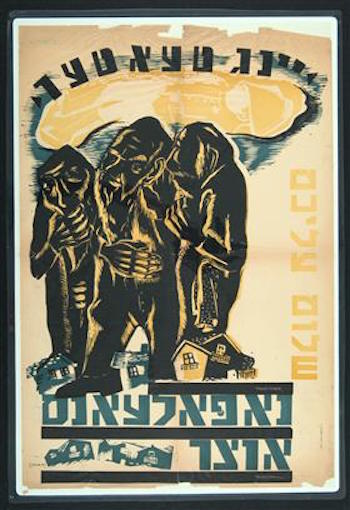Book Review: “Vilna My Vilna” — A Moving Memorial to the Lodestar of Yiddish Culture
In longing and loss, through the mouths of those he wished might speak still, Abraham Karpinowitz offers a salutation of the heart to his beloved city of Vilna.
Vilna My Vilna by Abraham Karpinowitz. Foreward by Justin Cammy. Translated from the Yiddish by Helen Mintz. Syracuse University Press, 224 pages, $19.95.

By Joann Green Breuer
In reality and myth Vilna, the ‘Jerusalem of Lithuania,’ has for hundreds of years been remembered as the center of Ashkenazic Jewish philosophy, aesthetics, and political inspiration. The aphorism was: ‘Go to Lodz for work, to Vilna for wisdom.’
To wit, heed the iconic folk tale featuring Yossele, the most adventurous inhabitant of the fictional village of Chelm. Chelmites, tired of being considered foolish by themselves and the world, send Yossele to Vilna so that he may bring some smarts back to Chelm, thus changing both its public reputation and self image. Yossele makes his long way to Vilna and seeks out its Mayor, clearly the wisest man in that great city. The official poses one question to Yossele: “Who is my father’s son, my mother’s son, but is not my brother?” For hours Yossele recites a raft of relatives, from half-brother to third cousin twice removed. To these responses the patient man shakes his bearded head: No. Finally, exhausted, Yossele gives up. “It is I, the Mayor of Vilna!” exclaims the triumphant Mayor. Yossele, thrilled, has acquired the wisdom for which he has been sent. He rushes home to share it with his Chelmite community. “Who is,” he asks the assembly, “my mother’s son, my father’s son, but is not my brother?” The Chelmites’ chorus day-long chorus of responses mirrors Yossele’s own: a series of relatives ranging from step brother to grand uncle. By evening the Chelmites, exhausted by the ordeal, beg for the revelatory answer. Yossele grants it: “It is,” he proudly announces, “the Mayor of Vilna!”
Thus has the knowledge of Vilna passed from generation to generation by way of nostalgic tales brimming with poignant humor; during that same period Vilna (Lithuanian Vilnius), once a lodestar of learning, became a seat of virulent anti-Semitism, both symbol and tragic center of the mid-twentieth century destruction of Yiddish culture and those who created and carried it.
The tradition of Vilna’s wisdom is highlighted by the life of Elijah ben Solomon Zalmen (1720-1797), the Vilna Gaon (an honorific). He become one of the most influential non-Hasidic rabbinic scholars and authorities. He stands out as an exemplar of Vilna Jewish scholarship, which maintained the significance of tradition while being surprisingly open to modernism. The value of intellectual pursuits was rigorously supported for centuries by the great library of Vilna. This collection can reasonably be compared in its importance to Jewish historical and spiritual concepts as the great library of Alexandria was to the consciousness of the ancient western world.
The Yiddish language, a homegrown amalgam of mid-millennium German, Russian, Hebrew, (and now English) — in other words, a linguistic history of the wandering of Jews — was codified (at least as much as possible) in the early twentieth century by Vilna’s Max Weinreich, who termed the city ‘Genius of place.’ Weinreich’s four volumes of the history of Yiddish are the bedrock reference volumes of the language. He authored the essential grammar text studied by twentieth century students who no longer hear the language as a mother tongue. YIVO, the Yiddish Institute and publishing house, was originally situated in Vilna; dedicated to the preservation of Yiddish language and culture, it is now located, and thriving, in New York City.
As for the arts, Vilna was home to Chaim Grade and Abraham Sutzkever, two of the most famous of the many poets who nourished and criticized each other’s works until they were murdered in the Nazi war. Vilna’s reputation as a magnet for cultural debate and creative turmoil developed through centuries of argument, philosophical and religious. The hunger for intellectual conflict culminated in 1915 with the formation of the Vilna Troupe, which, even after it moved to Warsaw in 1917, still bore the name and impressive cache of its birth city. In Vilna, the group was succeeded by the Yung-teater (1932-1939). Abraham Karpinowitz’s father was the impresario of this avant-garde stage troupe, where Kapinowitz’s sisters were actresses.
The socialist Bund (Workers’ Union) was established in Vilna in 1897. Members fell in and out of association with loosely organized cadres of revolutionary Zionists as well as the more formal Mizrahi religious group. Three centuries of volatile public discussion of high and low culture (politics, semantics, idealism, folk beliefs) inevitably led to the romanticization of Vilna, an idealization with more than a little validity. It is this love affair, and lamentation for its end, which Abraham Karpinowitz chronicles in this fine short story collection Vilna My Vilna, translated by Helen Mintz.

“Napoleon’s oytser” (Napoleon’s treasure). Yiddish poster advertising a Yung-teater production of a play by Sholem Aleichem. Artwork by M. Gruszka. Printed by P.O.L., Warsaw, 1934. Photo: YIVO.
Karpinowitz (1913-2004) was born in Vilna and had the good sense and luck to leave for Russia in 1937, thus averting the tragic fate of so many of his fellow Lithuanian Jews. He returned to what was left of Vilna a year after World War II, shocked by all that was no more. He soon moved to Israel, where he managed the Israeli Philharmonic Orchestra, and began writing in Hebrew and in Yiddish. One of his first known stories is “Never Forget,” which he clearly did not. Karpinowitz was a prolific writer in Hebrew and Yiddish: seven works of fiction, two biographies, one play, and five short story collections, all centered on tales of Vilna before the Shoah. He was awarded the Manger Prize, among several other honors.
The stories in Vilna My Vilna take the form of first-person narratives related in an artful, seemingly conversational style. They are each remembrances of Vilna while it was under Polish rule. While anti-Semitism rises there are poignant parallel growths in Jewish poverty and cultural life. The characters in Karpinowitz’s tales are blends of real and imagined figures, no doubt skillfully reshaped by the emery of memory. The confrontations, relationships, and events in these stories are infused with the energies of various ideologies. The underworld and the street are sites for colorful encounters that in less rigorous hands might have come off as stereotypical — but here they feel all too plausible. One is tempted to believe even the most causal (NOT ‘casual’) fiction.
The wife of one narrator, who plans a return to Vilna, pleads with her husband, “Don’t go, you’ll find nothing there but grief.” Grief is certainly present in each of these tales. Yet, more than grief glows here. As Justin Cammy points out in his caring forward, Karpinowitz finds the “heroic of the ordinary.” The cast of characters in Vilna My Vilna include: a lonely shoemaker,a wild bird purveyor amputee, a nail-biting felon with a penchant for politics and penury, a fishwife (of course) in a fish market heavy with the aroma of folklore. There are scenes of blood and benefactors, a tree which stands and a theatre which falls, an actor’s ego and an audience’s ovation, bewildered goyim who glimpse struggling Jews as they lurch toward annihilation. Through Karpinowitz’s darkly devoted pen, Vilna takes on a paradoxical aspect: “ashes of a dream,” “a decimated beauty.”
Mintz’s translation comes off as simple and earthy, respectful — sometimes almost to the edge of apology. She bows to that which is not translatable, not for the sake of semantics but because of sentiment. She provides a useful glossary of Hebrew and Yiddish terms, and occasional footnotes where a Yiddish emphasis or reference would be awkward in English.
Abraham Karpinowitz has taken what he terms “an opportunity of a dream” in this momento mori bene mirror of a memoir. In longing and loss, through the mouths of those he wished might speak still, he offers a salutation of the heart.
Joann Green Breuer is artistic associate of the Vineyard Playhouse.
Tagged: Abraham Karpinowitz, Eastern European Jews, Helen Mintz, Syracuse University Press


Could be I’m in an argumentative mood, but: “The Yiddish language, a homegrown amalgam of mid-millennium German, Russian, Hebrew, (and now English). . . ” bothers me.
What does that mean?
What language isn’t “homegrown?”
The implication is that r is a e, minus its own grammar. That it’s a *jarGON*, as it was accused of being by German Jews, among others, who spoke and wrote in respectable languages, and found Yiddish unformed and disreputable.
Yiddish had its own grammar for hundreds of years. And its own literature.
It’s still a living tongue, though mostly amount Hasidim. Which is the one thing I like about Hasidim.
Kind of silly and pretentious that Abraham Karpinowitz comes forth to rescue Yiddish.
I remember hearing I.B. Singer say, “They’ve been wondering for five hundred years if Yiddish has a future. They’ll be wondering for the next five hundred.”
Thank you. I love defense and defenders of Yiddish. Like American Sign Language, Yiddish is often disparaged as less than the full, rich language which it is. I should have included Polish in the stream of its waters, and perhaps mentioned the cleverly accurate imagery of its idioms and insults…. For centurues, for most European non-German/ non-Hungarian Jews, Yiddish was the home language, mamaloshen, mother tongue, as distinct from Hebrew, the synagogue communication – now lingua franca in Israel.
Joann, yes, Yiddish is mamaloshen, for me transmitted by bubby so, therefore, perhaps, bubbyloshen. She, as opposed to many Jewish immigrants of her generation, did not wish to protect her grandchildren from Yiddish. And when she did, I’d say, “Red tzu mir in Yiddish!” which she was only too glad to do.
From which I have concluded she was or had been some kind of Bundist.
I appreciate your comparing Yiddish to American Sign Language. It makes me think. But then again, whatever its achievements, American Sign Language was devised to compensate for people with a distinct sensory deficit, a manifest neurological otherness.
Yiddish has a different story. Different history — not to mention literature.